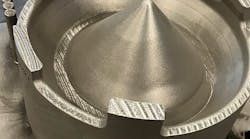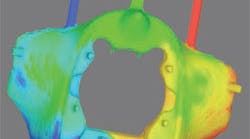Sand cores are an important component of many casting projects where there is a need to create open regions within a casting. Although sand cores have been widely used for many years, there remain numerous technical problems that can cause foundries significant loss of time and revenue. At the request of its users, Flow Science Inc. recently added three new modeling capabilities for improving the generation and use of sand cores.
Modeling the core shooting process
Beginning with the release of FLOW-3D® version 10.0, users will be able to simulate a core shooting process in which sand is blown into a die under high pressure. This new capability is based on specialized continuum models to represent the sand and air in a manner that is computationally fast. The model is able to capture unique features that characterize the flow of granular material such as packing and the angle of repose of a stable free surface. Air vents cut into a die may be automatically entered into a simulation from (STL) geometry files, or they may be individually defined by the user. Air vents are characterized by the diameter of the air channels, the open area of screens placed over the vent channels that prevent sand from entering, and the ambient air pressure at the exit of the vents. The grain size of the sand is an important input quantity, as it has a significant influence on the flow of the sand and air.
Other properties, such as the viscosity of an air/sand mixture, are evaluated within the software using established empirical formulae so that the user does not have to input these quantities.
An example of a simulated shooting of a sand core for use in the casting of a bathroom product is shown in Fig. 1. In this simulation, the flows entering the die from three nozzles are individually colored so that the regions filled by each nozzle can be assessed easily. (See Fig. 1)
Core drying capabilities
A second tool for improving sand core production is a coredrying simulation model. The core-drying model computes the transient drying of moisture remaining in the sand after it has been blown into a core die. Typically, drying is done by blowing hot air through the sand while still in the die. Simulating the heating, moisture evaporation and even temporary condensation of moisture in colder parts of the core makes it possible to optimize the drying process. This ensures complete drying while minimizing the energy costs associated with the heating and blowing of the air. Figure 2 (above) shows a snapshot of the remaining moisture content in a complex core after about half the initial moisture has been removed.
Simulating core-gas generation and defects
Finally, when sand cores are used in a casting, the sand binder is converted into gas by the hot metal, which could then percolate into the metal and cause gas-pocket defects. To prevent this from happening, metalcasters add vents to the cores.
However, it is difficult to predict what constitutes adequate venting because the processes of heating, gas formation and gas flow through a porous core are complicated multi-dimensional and time-dependent phenomena. To help design adequate core venting is the purpose of a third simulation capability that simulates the generation and flow of core gas during the casting process.
The core gas model predicts the amount and location of gas that is likely to enter into the metal. It offers a convenient way to check the effectiveness of venting schemes in connection with other operational parameters affecting the heating of the cores such as runner systems and pouring rates. A test case from General Motors involving sand cores used to create water jackets around cylinders of a V8 aluminum engine block is shown in Fig. 3. In the water jacket’s original design there was significant core gas bubbling into the metal near the top of the mold. A redesign, with increased core venting, solved the gas bubble problem.
Using these new sand core-modeling capabilities, foundries can quickly and inexpensively preview casting projects that use sand cores to ensure they have been designed well enough to avoid failure. Poorly-made cores or cores that lead to damaging gas defects can result in significant loss of time and income. The reputation of a foundry can only be enhanced when it acquires the ability to produce quality products quickly. (See Fig. 3.)
Dr. C.W. Hirt is the founder of Flow Science Inc. and a contributing developer to its FLOW-3D® simulation software. Visit www.flow3d.com for more information.













